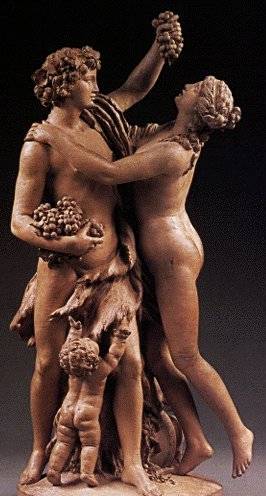|
|
|
Orphism -

Orpheus was one of the most famous poets
and musician whom ever lived. He was considered a founder of a religion and also a prophet. His priests had written
his holy words to a bible for dogma, behavior and ritual. He is seen as a gentle spirit, tender, meditative and
loving. He played the lyre so well and sang so melodious this was thought to have been a gift from Apollo. He married
the fair Eurydice. In some of my research it says that Eurydice was a dryad and his own mother was one of the Muses
most likely Calliope and his father was either Oeagrus a river-god or Apollo himself. Very probably he existed
according to historians.
Ovid tells of the marriage of Eurydice and Orpheus that Hymen(god of marriage) did not bless or give good omens towards
it. His wife was bitten by a poisonous snake and dies. He is so struck with grief he descends into Tartarus.
He charms the ferryman Charon, and the Dog Cerberus
as well as the three judges of the dead with his music.
Persephone and
Hades are
touched by his song and request that they grant it upon a condition. Orpheus was not to look back until they both had left the underworld and
were once again in the sunlight. Eurydice was a bit lame from the wound of the bite, she followed behind
him to the sound of his lyre. A bit to anxious when he alone had been once again under the suns ray looked back
prematurely and his wife is returned to her deathly state.
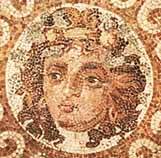
There are a few different versions of his own death but all claim that he was torn to shreds and his head floated
down the river Herbus singing. It landed at Lesbos where it was later buried and a temple to Dionysus was built
over the sight. His head was attacked by a jealous Lemnain serpent that Apollo turned into stone. Orpheus's
head was an oracle for Apollo whom later silenced him. The rest of the body was collected by the Muses and
buried at the foot of Mt.Olympus in Leibertha.
Both Ovid and Vergil's accounts of Orpheus's death say that the women of Thrace are to blame.What made them so hostile varies, either they were upset that he did not take to them after the death of fair Eurydice, or that he refused to let them become initiated into his mysteries, or even still that he drew their husbands away from them. Sometimes the women are Dionysus followers, who were sent by the god expressly against Orpheus, in attempts to convert Thrace to his religion met the opposition of Orpheus, a devoted follower of Apollo the sun god and sent his maenads to tear him into pieces.

Onomacritus a scholar edited Orpheus's songs (about 520) just as the Homeric lays had been edited a generation before. In the sixth century,
or earlier, the hymns were then considered sacred and divinely inspired. A mystical cult was formed from this that
was related to Dionysus. The creed was essentially an affirmation of the passion(suffering), death, and resurrection
of the divine son Dionysus Zagreus, and the resurrection of all men into a future of reward and punishment.
The Titans had killed Dionysus, Zeus struck them with his thunderbolt and from the ashes came mankind.
Thus man is partly evil and mortal but harbored in the soul is a particle of indestructible divinity. So here we
have the taint of original sin and the punishment for this soul was imprisonment being enclosed in the body. In
a mystic sacrament of communion of the Orphic worshipers ate the raw flesh of a bull as a symbol of Dionysus to
commemorate the slaying and eating of the god, and to absorb the divine essence anew.
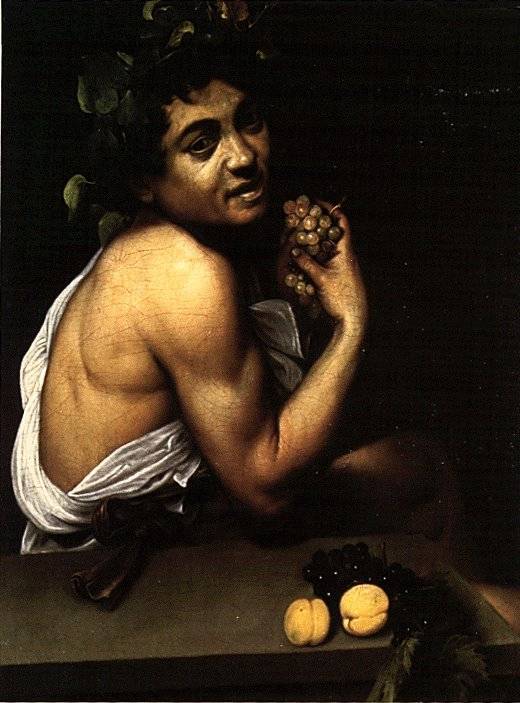
Birth, Childhood and Origins of Dionysus
The traditional tale of Dionysus Birth is that Zeus disguised himself as a mortal and had an affair with Semele, the daughter of Cadmus. When it was discovered by cow-eyed Hera she got extremely jealous and decided to get even. She visited Semele in her own disguise and convinced her rival that she should ask her lover to appear in the full magnificence of his divinity. So first Semele had persuaded Zeus to swear to her whatever she may ever ask of him.. then she revealed her demand. Zeus did not want to but he was obliged to comply by the oath he had sworn. Upon his appearance Semele was burned to a cinder by the splendor of his person and the fire of lightning flash. The child that was yet born was divine and was not destroyed in the conflagration. Zeus saved his child from the ashes of his mother. He then sewed him up within his thigh to term of the duration of pregnancy.There are a number of nurses associated with the infant Dionysus. Nysa was one such nymph, a mountain of legendary fame located in various parts of the ancient world. Semele's sister Ino, is also said to have cared or him. When Dionysus had reached adulthood, he carried the message of his worship far and wide, brining great euphoria and prosperity to those whom would listen and madness and death to those in opposition to his word.The tradition of his debut in Greece makes it obvious that is is a latecomer to the Olympian pantheon. His origins come from Thrace(of note: for example the Dionysiac aspect of Orpheus' missionary zeal) and eventually Phrygia.The date of when he was introduced into the worship of Hellas is difficult to obtain, it may belong to the period of transition after the fall of Mycenae (ca. 1100).
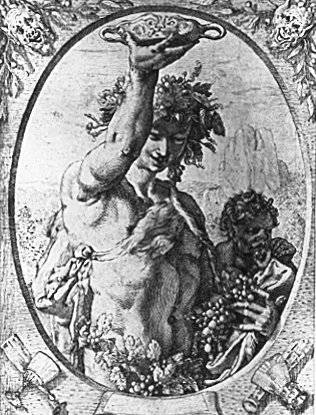
Homeric Hymn To Dionysus (59 lines)
(1-16) I will tell of Dionysus, the son of glorious Semele,
how he appeared on a jutting headland by the shore of the
fruitless sea, seeming like a stripling in the first flush of
manhood: his rich, dark hair was waving about him, and on his
strong shoulders he wore a purple robe. Presently there came
swiftly over the sparkling sea Tyrsenian pirates on a well-
decked ship -- a miserable doom led them on. When they saw him
they made signs to one another and sprang out quickly, and
seizing him straightway, put him on board their ship exultingly;
for they thought him the son of heaven-nurtured kings. They
sought to bind him with rude bonds, but the bonds would not hold
him, and the withes fell far away from his hands and feet: and he
sat with a smile in his dark eyes. Then the helmsman understood
all and cried out at once to his fellows and said:
( 17-24) `Madmen! What god is this whom you have taken and
bind, strong that he is? Not even the well-built ship can carry
him. Surely this is either Zeus or Apollo who has the silver
bow, or Poseidon, for he looks not like mortal men but like the
gods who dwell on Olympus. Come, then, let us set him free upon
the dark shore at once: do not lay hands on him, lest he grow
angry and stir up dangerous winds and heavy squalls.'
( 25-31) So said he: but the master chid him with taunting
words: `Madman, mark the wind and help hoist sail on the ship:
catch all the sheets. As for this fellow we men will see to him:
I reckon he is bound for Egypt or for Cyprus or to the
Hyperboreans or further still. But in the end he will speak out
and tell us his friends and all his wealth and his brothers, now
that providence has thrown him in our way.'
( 32-54) When he had said this, he had mast and sail hoisted
on the ship, and the wind filled the sail and the crew hauled
taut the sheets on either side. But soon strange things were
seen among them. First of all sweet, fragrant wine ran streaming
throughout all the black ship and a heavenly smell arose, so that
all the seamen were seized with amazement when they saw it. And
all at once a vine spread out both ways along the top of the sail
with many clusters hanging down from it, and a dark ivy-plant
twined about the mast, blossoming with flowers, and with rich
berries growing on it; and all the thole-pins were covered with
garlands. When the pirates saw all this, then at last they bade
the helmsman to put the ship to land. But the god changed into a
dreadful lion there on the ship, in the bows, and roared loudly:
amidships also he showed his wonders and created a shaggy bear
which stood up ravening, while on the forepeak was the lion
glaring fiercely with scowling brows. And so the sailors fled
into the stern and crowded bemused about the right-minded
helmsman, until suddenly the lion sprang upon the master and
seized him; and when the sailors saw it they leapt out overboard
one and all into the bright sea, escaping from a miserable fate,
and were changed into dolphins. But on the helmsman Dionysus had
mercy and held him back and made him altogether happy, saying to
him:
( 55-57) `Take courage, good...; you have found favour with my
heart. I am loud-crying Dionysus whom Cadmus' daughter Semele
bare of union with Zeus.'
( 58-59) Hail, child of fair-faced Semele! He who forgets you
can in no wise order sweet song.
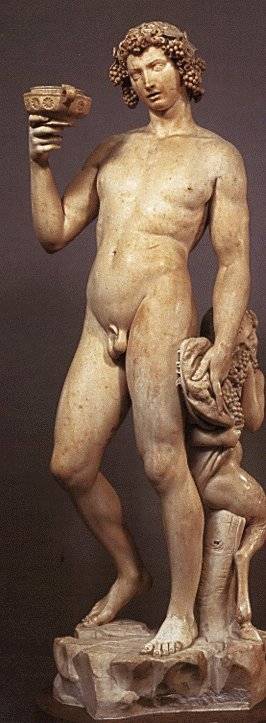
Homeric Hymn To Dionysus (21 lines)
(. 1-9) For some say, at Dracanum; and some, on windy
Icarus;
and some, in Naxos, O Heaven-born, Insewn ; and others by the
deep-eddying river Alpheus that pregnant Semele bare you to Zeus
the thunder-lover. And others yet, lord, say you were born in
Thebes; but all these lie. The Father of men and gods gave you
birth remote from men and secretly from white-armed Hera. There
is a certain Nysa, a mountain most high and richly grown with
woods, far off in Phoenice, near the streams of Aegyptus.
( 10-12) `...and men will lay up for her many offerings in
her shrines. And as these things are three , so shall mortals
ever sacrifice perfect hecatombs to you at your feasts each three
years.'
( 13-16) The Son of Cronos spoke and nodded with his dark
brows. And the divine locks of the king flowed forward from his
immortal head, and he made great Olympus reel. So spake wise
Zeus and ordained it with a nod.
(17-21) Be favourable, O Insewn, Inspirer of frenzied women!
we singers sing of you as we begin and as we end a strain, and
none forgetting you may call holy song to mind. And so,
farewell, Dionysus, Insewn, with your mother Semele whom men call
Thyone.

The first principle of Orphic Theogony was Chronus
(Time), who is at times described as a monstrous serpent
having the heads of a bull and a lion, with a god's face between them.
Chronus kept the company of Adrasteia ( Necessity),
and from Chronus came Aether, Chaos, and Erebus. In Aether, Chronus fashioned an egg that spilt in two, and from this came forth the
first born of all the gods, Phanes, the creator of all things called by many names one being Eros!
He had gleaming golden wings and four eyes, and has been described as having the appearance of several animals.
Phanes
bore a daughter, Night, who became his partner in creation, and eventually was his successor in Power. Night bore
Gaea
( Earth) and Uranus (Heaven), and then the begot the Titans. Then Cronus took charge of ruling from Night and
Zeus followed
and took the power from his father.
Then Zeus swallowed Phanes, and with him all of creation (including the peoples of the Golden Age) Zeus then created everything anew, with the help of Night. As second creator Zeus was the begining, middle and end of all things. In time Zeus mates with Persephone (Kore) and Dionysus is born.
After death, Orphic theology says, the soul goes down to Hades, and must face judgment by the gods of the underworld; the Orphic hymns and ritual, like the Egyptian Book of the Dead (The Papyrus of Ani with the Egyptian text is available with transliteration and translation by E.A. Wallis Budge, Dover), instructed the faithful in the art of preparing for this comprehensive and final examination. If found guilty there would be a severe punishment. One form of the doctrine emplies that this punishment is eternal, and transmitted to later theology the notion of a hell. Another form adopted the idea of transmigration : the soul was reborn again and again into lives happier or more sour that before according to the purity or impurity of it's former existence. This wheel of rebirth would turn until complete purity had been achieved, and then the soul was admitted into the Islands of the Blest. Or after the various stages of purification, an apotheosis, a union with the divine spirit in the realms of the upper aether. The seeds of everything came from Phanes or Zeus, out of the One, all things come to be and into the One they are once again resolved.
One variant offered hope that the punishment in Hades could be ended if one were to perform certain penances while living or after death by loved ones. In this way a doctrine of purgatory and indulgences arose; and Plato describes with almost anger of a Luther the peddling of such indulgences in the Athens of the fourth century B.C. :
Mendicant prophets go to rich men's doors
and persuade them
that they have a power committed to them of making atonement for their sins or those of their fathers by sacrifices
or charms...
And they produce a host of books written by Musaeus and
Orpheus...according to which they perform their ritual, and
persuade not only individuals but whole cities that expiations
and atonements may be made by sacrifices and amusements
(ceremonies?) which fill a vacant hour, and are equally at the
service of the living and the dead. The latter (ceremonies) they call mysteries, and these redeem us from the pains
of hell; but if we neglect them no one knows what awaits us."
Regardless there were in Orphism idealistic trends that culminated in the morals and monasticism of Christianity.
The reckless freedom of the Olympians was replaced by a strict code of conduct, and the mighty Zeus was dethroned
by the gentle figure of Orpheus, even as Yahweh was to be dethroned by Jesus. A conception of sin
and conscience, a dualistic view of the body as evil and the soul was divine entered into Greek thought; the subjugation
of the flesh became a main purpose of religion, as a condition of the release of the soul.
The brotherhood of the Orphic initiates had no separate life. They were distinguished by the wearing
of white garments and that they avoided partaking in the consumption of flesh food, and a degree of asceticism
not usually associated with Hellenic ways. They represented, in several ways, a Puritan Reformation in the history
of Greece. Their rites intruded more and more upon the public worship of the Olympian gods.
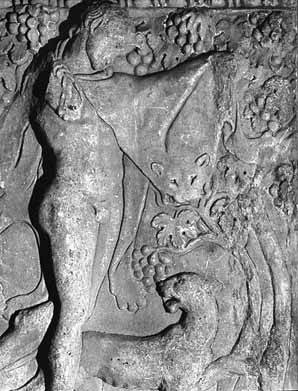
There is much in common with Christ and Dionysus. Both Christ
and Dionysus
are associated with the vine as beneath St. Peter's
basilica in the Vatican third and the fourth century vault in the church of Santa Contanza in Rome. There is a
third century wall mosaic showing Christ with the attributes of Apollo as sun-god. He ascends in the chariot of the sun, whose rays as
well as the cross emanate from his head, while in the background the vine of Dionysus is both a decorative
and symbolic feature. In the third century as well,
Christ appears as Orpheus in a fresco in a Christian
catacomb in Rome.
